Last updated on April 27, 2024
The latest addition to my collection is this Mappin Campaign trench watch, 1915. The name Mappin comes from Mappin & Webb, the iconic English jeweller. This Swiss made, antique watch has a 15-jewel Longines calibre 13.34 hand-winding movement which is working well. There was a lot to research on this particular timepiece, but as usual, it has been very rewarding. The watch is ticking loudly on my wrist as I type.
Trench watch
A trench watch is a type of wristwatch that became commonly used by soldiers during World War I. Although, they actually were first used some years earlier during the Boer Wars. Pocket watches were totally impractical for use in battle. Trench watches were intended to be durable and reliable, with features such as water-resistant cases and luminous dials that would make them usable in the challenging conditions of the trenches. Trench watches were also often equipped with leather or fabric straps that were easy to wear and adjust in the field.
Mappin & Webb
Mappin & Webb (M&W) is an international jewellery company headquartered in England. They are famous for retailing high-quality watches, silver and jewellery. Mappin & Webb was officially established in 1889 however its roots can be traced back to 1775 when Jonathan Mappin opened a silver smithing workshop in Sheffield. Apparently, he recorded his maker’s mark with the assay office and in 1780 was granted the Freedom of the Cutlers Company. I haven’t been able to find an example of Mappin’s assay mark. The business passed down from father to son until in the mid-18th Century when it became Mappin Brothers Ltd by Jonathon’s four great-grandsons, William, Edward, Joseph and John. William left the business in 1859 and gave his share of the company to the other three brothers.
In 1860, John left the company and started his own business, Mappin & Company, and opened a store on London’s Oxford Street. Two years later, in 1852, John’s brother-in-law, George Webb joined the business and the company was renamed to Mappin, Webb & Co. Unfortunately, George died in 1868, however, his name continued to be associated with the business. The company was first recorded as Mappin & Webb Ltd in 1889 at which point the focus was still very much on the manufacturing of silverware based in Sheffield. As a natural progression from silverware, Mappin & Webb began designing jewellery.
Mappin Brothers decline
Mappin Brothers Ltd continued to operate in Sheffield under the control of the two brothers Joseph and Edward who had expanded and created a very successful business. They were succeeded by Edward’s son Charles who sold it in 1884 after which the company went into decline and finally failed. It was eventually acquired by Mappin & Webb Ltd in 1903.
Mappin & Webb received their first Royal Warrant from Queen Victoria in 1897. In 1898, the acclaimed Mappin Campaign watch was launched. The end of the 19th and beginning of the 20th centuries saw a real focus on global expansion with the first overseas store opening in Johannesburg. By 1910 there were stores in another twelve locations including Biarritz, Rome, Buenos Aires and Cairo.
Royal patrons
The fine quality of the firm’s silverware attracted the attention of Royalty from Europe and beyond. Patrons have included Queen of France Marie-Antoinette, the Empress of Russia, and Princess Grace of Monaco. The company historically held Royal Warrants to both the Russian Empire and the Japanese Royal Household. They created many commemorative pieces for Royal occasions as well as important events. Mappin & Webb produced the original Ryder Cup trophy and made trophies for the Royal Ascot horse races for 75 years.
The family lost control of the business in the 1950s when it was the subject of a hostile takeover. Subsequently, all international stores closed in the second half of the 20th century. Since then, it has changed ownership many times. Mappin & Webb is still regarded today as one of Britain’s most prestigious jewellers. The company played an important role in the widespread popularisation of the wristwatch in the years immediately following World War I.
Longines
Longines was founded in Saint-Imier in 1832 by Auguste Agassiz, a Swiss watchmaker. Agassiz had two partners, lawyers Henri Raiguel and Florian Morel. The company’s original name was Raiguel Jeune & Cie. The business operated under the établissage system and was very successful. By 1846, Raigeul and Morel had retired, leaving Agassiz in charge of the company. In 1852, Agassiz brought in his enterprising nephew, Ernest Francillon, into the business.
Francillon was keen to adopt modern production methods. Under his leadership, the company began to move away from the old établissage system. In 1866, Francillon acquired land in southern St. Imier known locally as Les Longines (“long meadows”) where he established a factory. The factory was completed in 1867. Soon after, Longines produced its first in-house movement. The 20A movement was built with an anchor escapement and was wound and set via a pendant crown. The innovative movement won an award at the 1867 Universal Exhibition in Paris.
In 1878, Longines developed its first chronograph movement, the 20H. It was a very precise chronograph, accurate enough to be used in professional sporting events. This was when Longines began building its reputation in equestrian sports, such as horse racing and jumping. In 1880 the brand name Longines was registered in Switzerland. The famous winged logo was registered in 1889. To this day, Longines continues to be a reliable and precise timekeeping brand and continues to produce high-quality luxury watches.
Longines 13.34 movement
The Longines 13.34 savonnette movement was introduced in 1910 and was in production until the early 1930s. The Longines 13.34 movement operates at 18,000 vibrations per hour (vph) ticking five times per second. It has a straight-line Swiss lever escapement, a cut bimetallic temperature compensation balance, and a steel Breguet overcoil balance spring. This particular example of the 13.34 calibre has 15 jewels, in some cases, 13.34 movements were supplied with 18 jewels. Originally, the movement would have had a 36-hour power reserve when new.
The 13.34 movement is significant not only for its exceptionally high build and finish quality, but for being the largest movement that Longines manufactured for use in wristwatches at this time. The 13 in the calibre number is a reference to the 13 ligne size of this unit. The ligne, pronounced “line”, is the unit of width measurement traditionally used in the Swiss watch industry. One ligne is the equivalent of 1/12 of an old French inch, which is about 2.256mm. The 34 value will be the equivalent of a model number. The calibre number 13.34 is stamped on the top of the bottom plate and is visible next to the escape wheel. The movement is pin set. This means that the time is set by pushing the small button just beneath the crown and then turning the crown to move the hands.
Case
The watch measures 35mm in diameter excluding the winding crown and the fixed wire lugs. The case material is silver and there are British hallmarks inside the two case backs for London 1915. Additionally, there is a sponsor’s mark, AB, for Arthur Baume of Baume & Co, importers of Longines watches into the UK. The case is in near-mint condition, as is the mineral glass crystal. The movement is protected by an inner hinged dust cover, also known as a cuvette.
Dial
The dial is signed Mappin (of Mappin & Webb), with the brand name “Campaign”. It is the model shown in the advertisement shown below from 1915. The advertisement claims the “Mappin Campaign” watch was first used in great numbers during the Battle of Omdurman. The battle took place on 2 September 1898, at Kerreri, 11 kilometres north of Omdurman in Sudan. I am not certain that this was the case as I have not seen any Mappin Campaign wristwatches dating before 1910 during my research. I suspect this might be a marketing tactic.
It is also interesting that Mappin & Webb were claiming to be watchmakers to the Admiralty when all they did was retail watches. The advertisement claims that the watch was “absolutely dust and damp-proof”. This is a bold claim as no hinged case would ever truly be dust and damp-proof. However, some Mappin Campaign watches were issued with Borgel cases, which were virtually waterproof.
This advertisement from 1901, shows a slightly different Mappin Campaign watch. In this instance, it shows a pocket watch, called “The Campaign”, which is held in a pouch that can be strapped on the wrist. The brand may have remained the same, but the type of watch certainly didn’t.
Luminous paint
Originally, the cathedral hands and Arabic hour markers would have been filled with radioactive luminous paint. The paint was made with a mixture of radium and zinc sulphide phosphor doped with an activator, usually copper. The zinc sulphide phosphor glowed brightly when hit by radiation from the radium, which meant that the time could be read in the darkness of the trenches. The paint usually lasted about 3 years before the zinc sulphide phosphor was consumed. The dial and hand would then need to be repainted.
In the 1920s it became known that radioactive paint was dangerous and the paint was often removed. Traces of the paint remain on the hands although this is only obvious under magnification. On the enamel dial, there is a very faint hairline running horizontally from number 10, but it is difficult to see with the naked eye. There is also a small chip at the edge of the dial but this is mostly covered by the bezel and does not in any way detract from the watch.
Summary
This Mappin Campaign trench watch dating from 1915 is stunning. It is in amazing condition for a watch that is 108 years old at the time of writing. After, a 24-hour timekeeping test. The Longines 13.34 movement proved to be accurate to within one minute (fast) with a power reserve of just under 32 hours. It is a reliable and very presentable timepiece which I will enjoy wearing over the coming months. It was really interesting to delve into the history of Mappin & Webb. I was particularly pleased to find evidence that the pre-1900 Campaign watches, were not in fact wristwatches, but pouched pocket watches. Overall, I am very pleased to have this antique watch in my collection.
Related content
The official website of Mappin & Webb.
Mappin & Webb at Wikipedia.
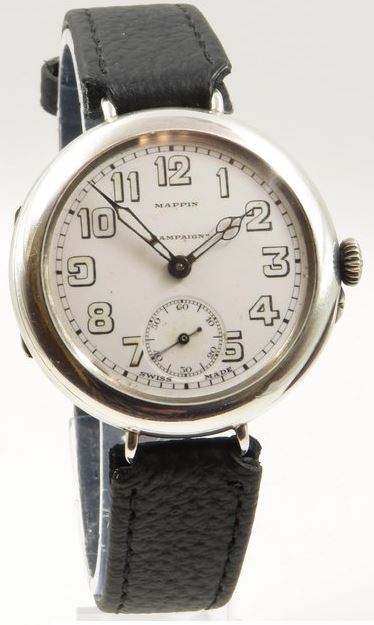
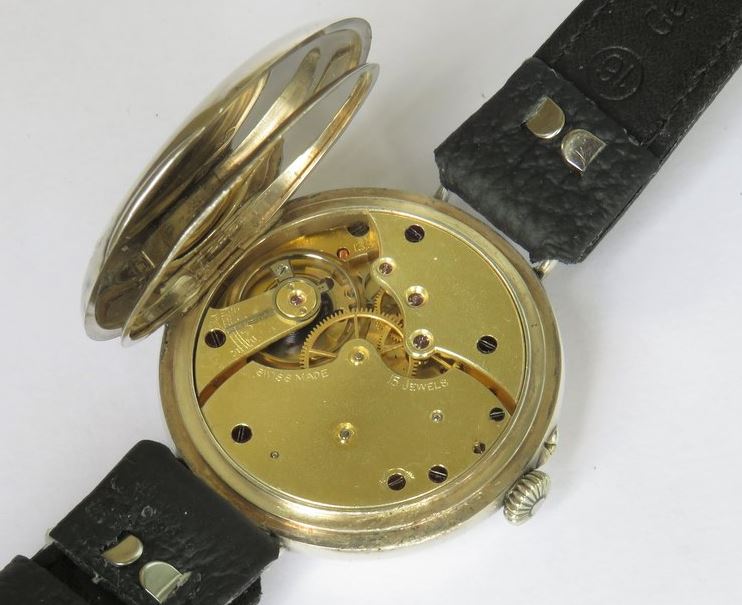
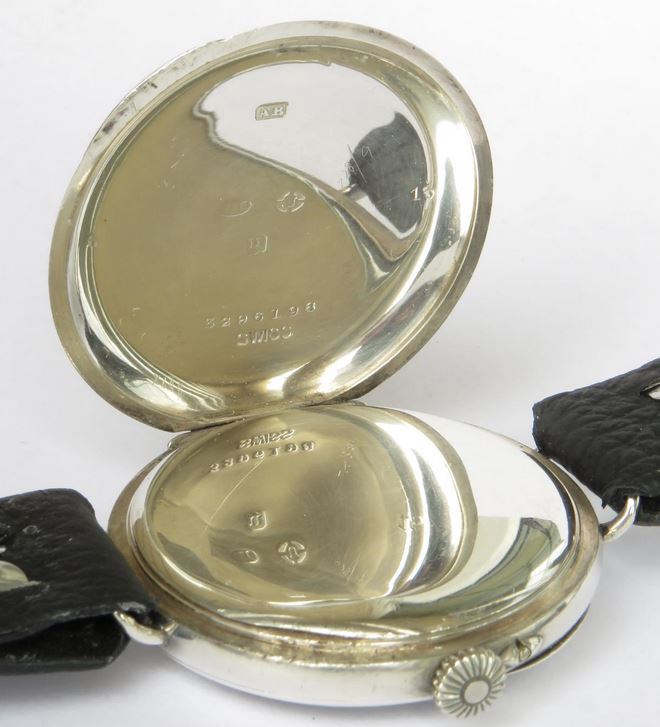
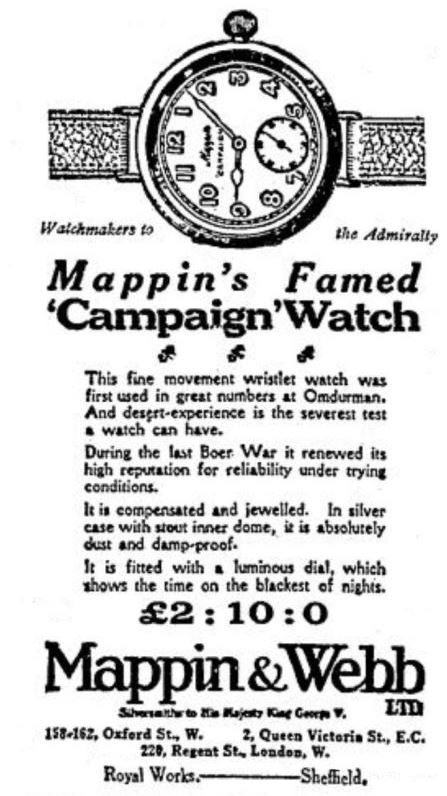
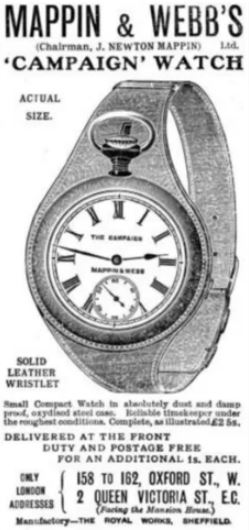
A stunning watch and a very informative post. Did all of the World War One trench watches have luminous dials? And is the luminous paint usually removed from surviving models? Are they accurate and useable as daily watches? Keep up the good work, Francesco
Hi Francesco, thanks, it is a really nice trench watch. It is incredible to believe that it is over a hundred years old and still working well. I wear it probably once a month and it keeps good time, so it is definitely useable. I am not sure I would use it as a daily watch, ultimately wear and tear is going to take its toll and I’ll need a repair. Not all WW1 trench watches had luminous paint, some of the early pieces had a red 12 as an orientation point, this Fonetainemelon silver trench watch from my collection is an example. Once it was realised that radium was dangerous, most of the luminous paint was removed. Some trench watches still contain traces of the paint, but I tend to avoid those trench watches. Thanks for taking the time to comment, Jason